
Well, in my neck of woods/water it is so COLD I’m considering pulling a buzzbait along the ice and watching the bass bump their heads.
OK, OK. Seriously, in my home area of the Mid-South, we typically can fish nearly year-round. And I do catch a lot of fish in the cold. In fact, in a show that aired last this year on Bill Dance Outdoors on Versus TV, you may have seen me pull a bait off the edge of the ice, and as it fell, I got bit!
But today, as I sit here in the warmth of my office, thinking of fishing (what else?), I want to share with you a tip that I have found to work when fishing small lakes in winter.
What I do is find a small impoundment with clear water and little to no cover. Then, I go to the deepest area. After many a cold trip staring at electronics in these conditions, I’ve discovered bass will be found suspended at the deepest area’s halfway point.
For example, if you are at the dam of a lake and it is 20 feet, if the conditions are right (clear water and limited cover), expect to find fish suspended at the mid-range depth of 9-12 feet.
The phenomenon is commonplace, and I really don’t know why. I could guess it has something to do with water density in cooler temps, pressure on the swim bladder…? Nothing is certain. But I do know that it makes them easier to locate, and that I’ve devised a way to catch them when they hold halfway down.
I fish a 5-inch Yum Houdini Shad (experiment with colors) on a 5/0 Gamakatsu Skip Gap hook (with no weight). I use a medium-action Quantum Energy 6-1/2- to 7-foot rod and a Tour Edition baitcaster loaded with 14-pound mono — all help with casting, line-movement, longer casts and hook sets.
Using the countdown method, I mentally count to whatever depth (number) the graph locates the fish. Sometimes the “tick” of a strike is immediate at the desired depth, but often I have to twitch the rod tip slightly. This twitch and a slow retrieve help keep the bait in the strike zone longer. A single cast and retrieve, could take two minutes (if you don’t get bit). Of course, the deeper the water, the slower the process. But successful winter fishing is always slow and methodical.
I zigzag around with the trolling motor and electronics to find them, and then back off and fancast the area.
It’s a slow presentation for clear water with little to no cover. And though it works on small waters, you can also try it in coves on larger reservoirs.
The technique is highly effective and you often catch a variety of species of bass on one trip. This really produces bass in the toughest of conditions — when the water is ice-cold and clear.
Also remember, as with any winter trip, you must have the mindset that you’ll not get as many strikes when the water is 40-43 degrees. You have to stick with it. But trust me, the method pays off.
‘Til next time, stay warm and c-c-c-catch one for me!
For more words of wit and wisdom from one of our sport’s greatest legends, check out www.billdanceoutdoors.com.
Originally published January 2010





